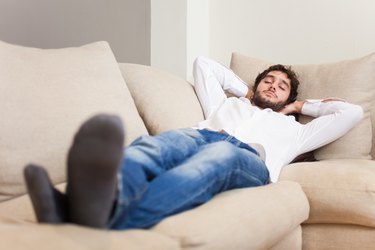
When you feel hungry, eating should make you feel better. But for some people, eating makes them feel worse, due to a drop in blood sugar that occurs within one to three hours after they eat certain types of meals, according to Frank Jackson, M.D. of Jackson/Siegelbaum Gastroenterology. This reaction, called reactive hypoglycemia, can cause a number of unpleasant side effects. Reactive hypoglycemia can also indicate insulin resistance, often considered a forerunner of diabetes, the National Diabetes and Digestive and Kidney Disorders states.
Mechanism
Video of the Day
Glucose is essential for energy; your body breaks down the foods you eat into glucose, which must be absorbed into the cells. When glucose enters the bloodstream, your body releases insulin to facilitate its absorption into the cells. In some people, too much insulin is released in response to glucose. The insulin removes too much glucose from the bloodstream, and blood sugar levels drop. People with insulin resistance have higher than normal amounts of circulating insulin because their cells have become resistant to the effects of insulin; it takes a larger amount of insulin to get the cells to respond and remove glucose from the bloodstream.
Video of the Day
Glycemia Load and Glycemic Index
Foods that have a high glycemic index, which means that they break down more rapidly into glucose after being eaten, raise blood sugar very quickly. Generally speaking, carbohydrate foods high in refined sugars or simple sugars have a high glycemic index. The sudden influx of glucose causes the release of large amounts of insulin, which removes too much glucose and causes blood glucose to drop. Eating foods with a low glycemic index helps avoid dropping blood sugar levels after eating. Glycemic load, which considers the amount of carbohydrates in a food along with its glycemic index, determines a food's effect on your blood sugar.
What to Eat
Foods high in carbohydrates have a bigger immediate impact on your blood sugar levels than proteins or fats. But not all high-carbohydrate foods have a high glycemic load. Fruits, for example, which consist of simple sugars, have a low glycemic load because they contain fewer carbohydrates than some other foods and they're also high in fiber. High fiber foods like fruits and vegetable slow food breakdown, which helps stabilize blood glucose levels. Soda, which contains a lot of carbohydrates and simple sugars, has a much higher glycemic load and can cause your blood glucose to rise quickly right after drinking. Refined grains have a higher glycemic load than whole grains. Eating protein and some fat with a meal slows food digestion, which also results in a slower rise in blood glucose. Registered dietitian Joanne Larson recommends following a diet made up of 20 percent protein, 30 percent fat and around 130 grams of carbohydrates per day if you have hypoglycemia.
Symptoms and Treatment
Symptoms of hypoglycemia include sweating, shakiness, weakness, lightheadedness, confusion, difficulty speaking and possibly fainting. When you first feel symptoms of hypoglycemia, eat a protein-based food such as cheese or a piece of meat along with a small amount of carbohydrate, such as a piece of fruit. Do not eat a piece of candy, as is often recommended for diabetics with hypoglycemia, Larson warns. Simple sugars will raise your blood sugar quickly, but another large insulin release could cause rebound hypoglycemia. Preventing symptoms from developing by following a diet low in refined carbohydrates helps prevent reactive hypoglycemia from developing.
Is this an emergency? If you are experiencing serious medical symptoms, please see the National Library of Medicine’s list of signs you need emergency medical attention or call 911.